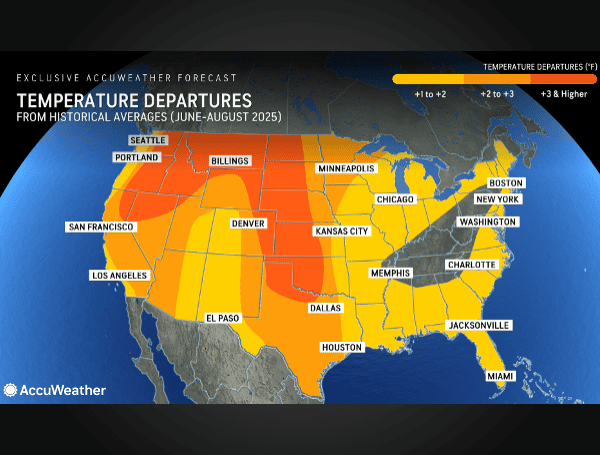Get ready for a long, hot summer. AccuWeather’s long-range meteorologists are forecasting above-average temperatures across a staggering 45 states this meteorological summer, which runs from June 1st through the end of August. This widespread heatwave is anticipated to drive up electricity bills for families and businesses nationwide as demand for cooling soars.
AccuWeather Lead Long-Range Expert Paul Pastelok warns that the next three months will bring a barrage of weather extremes, including “sweltering heat, severe weather, intense wildfires and the start of a dynamic Atlantic hurricane season.”
READ: Deadly Derecho Leaves Millions Without Power Across Ohio Valley; 1 Dead In Pennsylvania
“Make sure your air conditioners are ready for another hot summer across much of the country, especially the western and central U.S.,” Pastelok cautioned. “We expect a summer with more extremes, including extreme heat waves, expanding drought and the potential for big wildfires and major hurricanes later in the summer.”
The only regions expected to see normal to below-average temperatures are parts of the interior Northeast, interior mid-Atlantic, and the Tennessee Valley. However, Pastelok notes that even these areas will experience hot and humid stretches.
What’s Fueling the Furnace?
Many areas have already experienced a preview of the summer heat this spring. Phoenix, for instance, reached the 100-degree mark on April 10th, the earliest it has hit that milestone in seven years.
Looking ahead to June through August, the most intense heat is predicted for the northern Rockies, the Northwest, and across the Plains, where temperatures are forecast to be “well above average” due to persistent high pressure.
While the monsoon season is expected to bring some relief to the Southwest later in the summer, the overall trend points towards a significantly warmer-than-usual season for the vast majority of the country.
READ: AAA Offers Free Catalytic Converter Theft Prevention Event In Clearwater
Power Bills Set to Climb
The prolonged heat will inevitably lead to a surge in electricity consumption as millions crank up their air conditioners, fans, and other cooling devices. AccuWeather anticipates that the demand for electricity will climb above historical average levels across parts of 33 states this summer.
Pastelok highlighted the critical role of soil moisture and drought in this equation. “We expect the middle of the country to dry out and bake in the summer heat. Higher air temperatures can enhance evaporation rates, which further reduces soil moisture. The hotter and drier it gets, the more families and businesses will depend on air conditioning.”
He emphasized that air conditioning is no longer a luxury in many parts of the western and central U.S. but a necessity for safety. “Power outages in triple-digit heat can quickly lead to a life-threatening situation. Extreme heat is the deadliest weather hazard in the U.S.”
READ: New Generation Of Shuttles Arrives At Tampa International Airport, Ushering In Modernized Travel
Heat Waves on the Horizon
AccuWeather’s experts are forecasting the possibility of strong to extreme heat waves, particularly in the western, central, and northwestern U.S. Cities like Spokane, Boise, and Billings are expected to bear the brunt of the scorching heat.
While the Northeast and Appalachians may see some respite from the heat with showers and thunderstorms, higher humidity levels will still make it feel significantly hotter, according to AccuWeather RealFeel® Temperatures. Plentiful spring rainfall may help keep summer temperatures in the average range for parts of the interior Northeast, interior mid-Atlantic, and Tennessee Valley, but warm and muggy nights will still necessitate air conditioning.
Interestingly, AccuWeather predicts fewer 90-degree days this summer in major Northeast cities like New York City, Philadelphia, and Washington, D.C., compared to last year. The frequency of such hot days is expected to remain similar to last year in western and central cities like Minneapolis, Dallas, Denver, Los Angeles, Phoenix, and Portland.
More Than Just Heat: Storms, Wildfires, and Hurricanes Loom
The forecast isn’t just about the heat. Areas in the eastern U.S. that escape the most intense temperatures may face an increase in showers and thunderstorms, with a risk of severe weather. Warm Gulf waters could fuel intense storms, including derechos – powerful, widespread windstorms – which pose the highest risk to the northern Plains, Ohio Valley, and Tennessee Valley in June and July. Later in the summer, tropical storms and hurricanes could also contribute to tornado activity.
Meanwhile, the North American monsoon is expected to bring above-normal rainfall to the interior West, potentially easing drought conditions but also increasing the risk of flash flooding and mudslides. The peak of lightning activity during the summer also elevates the risk of wildfires.
Speaking of fire, AccuWeather anticipates worsening drought conditions in many of the same areas experiencing extreme heat, particularly across the High Plains and West. This will likely lead to an escalation of the wildfire season. The AccuWeather 2025 U.S. Wildfire Forecast warns of “very high” to “extreme” fire risk in parts of the Southwest, Texas, Rockies, and interior Northwest.
Adding another layer of concern, AccuWeather’s hurricane experts are predicting a dynamic Atlantic hurricane season, fueled by warm Gulf, Caribbean, and Atlantic waters.
There’s even a chance for a subtropical or tropical storm to develop before the official start of the season on June 1st. The northern and eastern Gulf Coast and the Carolinas are identified as being at a higher-than-average risk of direct impacts this season.
“Hundreds of record high temperatures were shattered across the country last summer. We’ll likely experience more record high temperatures being challenged or broken again this summer, especially in the western and central U.S.,” AccuWeather Climate Expert and Senior Meteorologist Brett Anderson stated. He also highlighted the increasing health risks associated with prolonged exposure to extreme heat and the strain on the power grid and water supplies.
Please make a small donation to the Tampa Free Press to help sustain independent journalism. Your contribution enables us to continue delivering high-quality, local, and national news coverage.
Connect with us: Follow the Tampa Free Press on Facebook and Twitter for breaking news and updates.
Sign up: Subscribe to our free newsletter for a curated selection of top stories delivered straight to your inbox.

